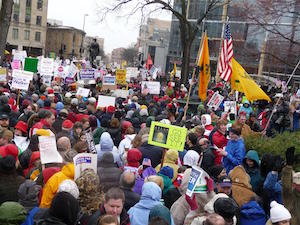How to Sustain Your Activism
By Stephen Murphy-Shigematsu
These three principles can help activists avoid burnout and continue working toward a better world.
 The Women's March on Washington following President Donald Trump's inauguration
The Women's March on Washington following President Donald Trump's inauguration
These three principles can help activists avoid burnout and continue working toward a better world.
Thanks to recent events, many people have felt motivated to march in the streets, call their Congressional representatives, or even make protest art. People who have never seen themselves as activists are now feeling the need to do something. Veteran activists are facing the challenge of a renewed effort without suffering burnout. Many of us are feeling a sense of fatigue, after months and months of threats to civil liberties, human rights, and the integrity of our institutions. At such a time, we all need to know how to sustain activism over the long run.
 The Women's March on Washington following President Donald Trump's inauguration
The Women's March on Washington following President Donald Trump's inauguration
Mindfulness offers a way.
For many of us, mindfulness is more than an individualistic way of reducing stress. As Thich Nhat Hanh teaches, making peace begins within ourselves, but contemplation leads to compassion, and compassion involves taking action to address suffering. This work to transform the world through social, political, economic, or environmental change is activism.
Here are three principles of sustainable activism drawn from the inspirational teachings of Grace Lee Boggs, a lifelong activist until she passed away in 2016 at the age of 100. Boggs spoke of a cultural revolution in which we are transforming how we view ourselves, our surroundings, and our institutions. She advocated making a life, not just a living, by feeding ourselves, educating our children, and taking more responsibility for each other and our communities.
1. Come alive
Recent research shows how many people are motivated by the pursuit of meaning—and for many of them, activism is the most intensely meaningful work they’ll ever take on. It is awakened by a sense of being called to do the work—and it is sustained by coming alive with the feeling of finding meaning in one’s work.
Boggs teaches that activism means seeing that “we are the leaders” and that we can be the change we want to see in the world. That doesn’t mean we take on the entire burden of change to ourselves; it means that we find a role to play. There are many different forms of activism, and each person can contribute according to their abilities, thinking globally and acting locally.
While there are self-defined or self-styled activists, everyone in their daily practice has both the ability and responsibility to change the way we relate individually and collectively to each other and to our social world. Mindfulness practice enables us to know who we are and what we can do and then to do it.
This can be as simple as mindful breathing, focusing attention on your breath, inhaling and exhaling, especially when you’re feeling particularly stressed or anxious. Nothing will make you more aware of being alive than counting your own breaths!
2. Connect
The research to date says that social connection is the single biggest predictor of personal happiness—and activism is nothing without a sense of connection. It is sustained by uniting with others in the struggle, reminding us that we are not alone. Indeed, studies also suggest that our feelings of connection don’t just make us feel good, they make us do good acts.
Connecting with those we perceive as enemies is also crucial. We must resist injustice, and we must resist giving in to the destructive separation of ourselves from others by dividing people as “us” and “them.”
Mindful meditation may enable us to see others clearly and listen deeply, making us aware of our interconnections with all beings. There is a specific kind of meditation called loving-kindness that can help enhance that sense of connection, including compassion for those we regard as enemies or those who have harmed us.
Connecting also means not abandoning the system, but instead seeing ourselves as part of it. Boggs reminds us that you cannot change any society unless you take responsibility for it, unless you see yourself as belonging to it, and responsible for changing it.
3. Care
Activism springs from caring—and it calls us to widen our circles of compassion to include all creatures and the earth itself.
That compassion must start with ourselves. Mindful self-compassion is not about letting yourself off the hook. As spiritual activists of many traditions—such as Thomas Merton, Mahatma Gandhi, and the Dalai Lama—have taught, cultivating compassion for ourselves is what allows us to be truly compassionate to others. Indeed, research suggests that mindfulness meditation practices may increase compassionate responses to suffering. That same research provides evidence that compassion also motivates us to take action in the world.
As psychologist Paul Ekman has argued, anger has a place in activism. But anger is not sustainable; anger burns too hot for a lifetime. Boggs saw tending gardens, caring for the self, and caring for others as nourishing activism. Those acts of care are what will carry us through our most difficult times, as individuals and as a society.
While activism requires courage to act boldly for social change, it also demands acceptance of what we can’t change. We need patience and understanding that it’s a long haul and we’re not the first ones who have tried to change the world. Making a peaceful and just world is not a one-time event but a sustained process tied to slow evolutionary change. Mindfulness practices can help us to remain present in the moment, engaging in the struggle, and grateful for the opportunity to serve.
